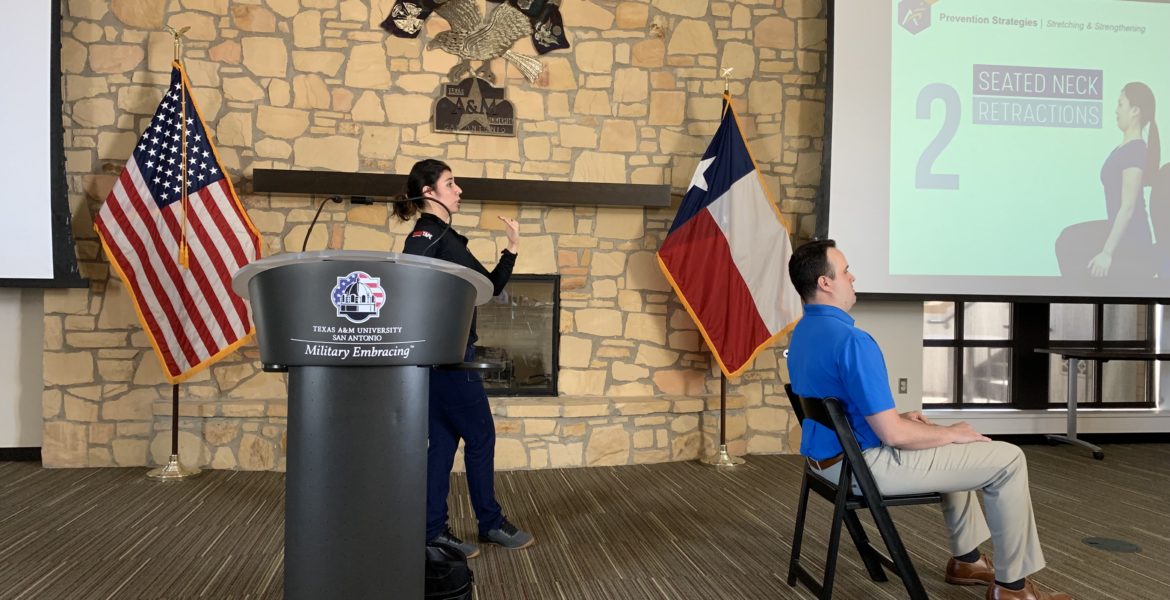Headaches are a pain in the neck for everyone, but the cause of that pain might be surprising, a local chiropractor said April 15 at Texas A&M University-San Antonio.
Dr. Ana Canelo, a certified Airrosti provider, co-presented “Lunch and Learn: Headaches-It’s Not Just in Your Head” to about 30 employees in the Ceremony Room of Patriots’ Casa. She and Jonathan Surls, strategic account executive for Airrosti, discussed the causes of headaches and ways to treat them.
Airrosti stands for Applied Integration for the Rapid Recovery of Soft Tissue Injuries.
“The safest thing would be, if you are dealing with a headache, is find the appropriate provider, whether that’s with us or someone else,” Surls said.
Canelo said headaches can be triggered by several factors, but focusing on the cause could help diagnose and eliminate chronic pain.
The six types of headaches are TMJ, sinus, cluster, tension, migraine and neck pain, Canelo said.
The first step is identifying the headache by location and symptoms.
Sinus headaches tend to occur in the middle of the forehead close to the eyes and are accompanied by itchy or watery eyes and nasal congestion. Allergies are a common cause.
Headaches can also be a symptom of pain radiating from another area of the body. TMJ headaches, located on the side of the head, can be triggered by dental issues, trauma and chewing, clicking and grinding of the teeth.
One attendee said excessive laughter causes her TMJ headaches.
“So, when I’m with my brother, every time, I get one of those [TMJ headaches],” Luann White, ITS help desk coordinator at A&M-San Antonio, said during the presentation. “I can’t open my mouth because he makes me laugh so much. I go, yeah, this is what my copay is because I’m gonna have to go to the doctor’s.”
Cervicogenic or secondary headaches are triggered by neck pain that moves from the neck to the head.
Migraines, which can be so painful that they can make sufferers collapse in pain, can be triggered by hormonal changes, noises, smells and even changes in weather. Other causes include stress, trauma and physical activity.
“Some patients tell me they have to go lay down in a dark room to help the headache go away. Otherwise, even a little bit of movement could make it worse,” Canelo said.
Cluster headaches are felt around the eye and temple and can last between 15 minutes to two hours. Also, swelling of the eye and nasal congestion may occur.
Tension headaches are usually felt in the back of the neck and can possibly wrap around the head. This can be caused by body stress from poor posture.
Documenting pain can aid diagnosis
Writing down symptoms can help a person’s healthcare provider to better understand what type of pain they’re experiencing and if it is more than just a common headache. Tracking the date, time, location and severity takes away the guesswork for the doctor. It will also help to write down the duration and activity that led to the pain.
“This is really just a way to document the headache and track them a little better so when you go see a doctor it will point them in the right direction,” Surls said.
Canelo stressed it is important to be as accurate as possible when describing symptoms to one’s doctor, especially when it comes to pain.
“This is one thing that I struggle sometimes with patients. I say what is your pain level and they say 10,” Canelo said. “Ten should be the type of pain like you just got attacked by a bear. If you’re sitting and smiling, it’s probably not a 10.”
In addition to tracking symptoms, Canelo recommends maintaining postural awareness and knowing one’s pain triggers to help alleviate common headache pains. Stretching can also ease some pain but be careful and listen to the signals your body tells you.
“Stretching too much can make it worse. Remember to breathe and don’t force it. You should feel a little tension but if it gets too painful, stop,” Canelo said.
Speakers share exercises for neck, shoulders
Canelo and Surls demonstrated three exercises that can prevent injuries and headaches.
The SCM, scalene and trap stretch can be done sitting down or standing up. The head makes alternate movements side to side depending on which neck muscle needs to be stretched.
The seated neck retraction is done by sitting down, gliding “your head back into a retraction and then forward,” Canelo said.
This exercise is often used with tension headaches because it relieves the pain in the back of the neck while also strengthening the deep neck flexors.
The shoulder blade posture setting was described as the basics of proper posture.
“Imagine that somebody’s pulling your shoulders down and then you’re going to retract back,” Canelo said.
Canelo and Suls handed out headache trackers to attendees.
“To me, it’s very viable when you can go to a lunch and learn and you can learn something that you can do today,” said Nan Palmero, assistant director of Marketing and Communications at A&M-San Antonio.
Employees who use the Blue Cross Blue Shield health plan through the A&M system can visit Airrosti and pay a $30 copay with no referrals needed, Surls said. Airrosti rehab centers can be found in Washington, Illinois, Ohio, Virginia and Texas. The closest one to campus is Canelo’s office, R. Family Medical Group, near Lackland Air Force Base and Mission Concepcion at 3110 Nogalitos St.







